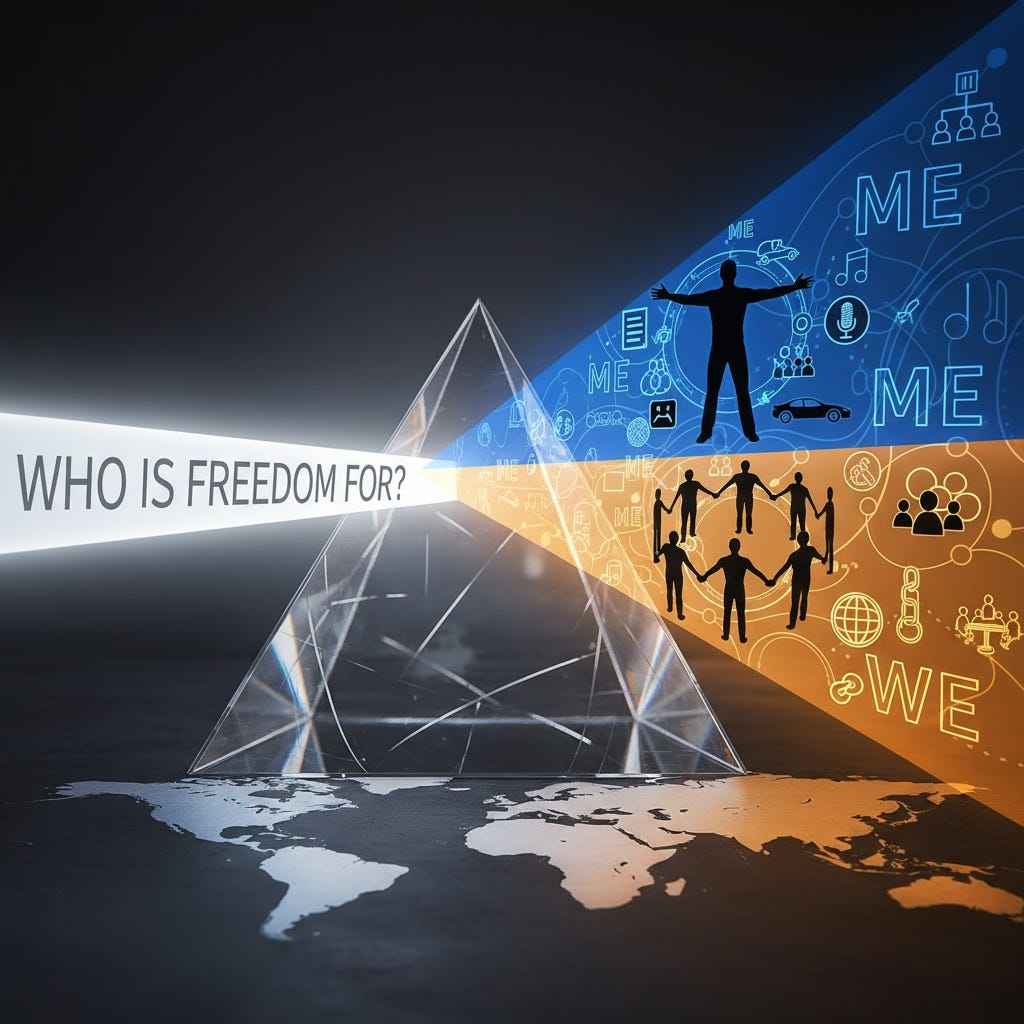Tuesday Edition — Who Is Freedom For?Individualism vs. Collectivism
Freedom Isn’t What You Think It Is — A Cultural Analysis
Who is freedom for?
This is a nonsense question for Americans and many Westerners because freedom is always about “me.” Freedom is doing what “I” want. It is pursuing “my” desires, “my” goals, and “my” wants. Who else is freedom for if not “me?”
In individualistic cultures, freedom is designed for the individual, for the person acting. But, in collectivist cultures, freedom is designed for others, for the people affected by the actions.
That difference changes everything.
Freedom as Independence
In much of the West, freedom means the right to act without permission, to speak one’s mind, choose one’s work, or live according to one’s beliefs. It’s visible in everything from protest rallies and entrepreneurial start-ups to online debates where every opinion demands an audience.
This version of freedom assumes that the individual, not the community, is the central unit of life. People decide for themselves what’s right; institutions exist mainly to protect individual choices. In the United States, this logic underpins everything from gun ownership and business deregulation to the refusal of mandatory health measures during a pandemic.
Hofstede called this individualism, and it defines societies such as the U.S., Australia, and much of Northern Europe. In these cultures, success and failure belong to the individual; a person’s life is largely seen as the outcome of their own decisions. “Freedom to” dominates: the freedom to build a company, to voice dissent, or to live outside convention.
The result is a society that celebrates innovation and personal expression but accepts inequality and conflict as the cost. The freedom to speak against the government can destabilize the government. The freedom not to wear a mask during a pandemic can kill others. The freedom to play loud music takes away another person’s right to quiet.
When freedom is measured by choice, it creates a society in which all people are free, but some people are more free than others. And those with more money and power are inevitably the freer.
Freedom as Relationship
In collectivist cultures, freedom is defined by how one’s actions affect others. The goal is social balance, the freedom to live without conflict, to have stability, safety, and harmony. To live one’s life without others infringing on your rights.
This form of freedom shows up in daily life. In Japan, subway passengers rarely speak on their phones or eat during commutes. It’s the freedom of peace and order in crowded conditions. In South Korea, citizens are expected to follow public guidance during emergencies, mask-wearing, for example, because people should have the freedom to be in public without getting sick. In Singapore, strict public rules about littering or vandalism are widely supported, because people want the freedom to walk through clean, safe streets without disruption.
Hofstede described this orientation as collectivism: the group, not the individual, is the main point of reference. Freedom, in this sense, means being free from social chaos, from the uncertainty that comes when everyone does only what they please. It’s the freedom that comes from stability. Peace and cooperation are themselves forms of freedom.
Collectivist freedom can come at a personal cost. The worker who stays silent to keep the peace loses the freedom to question unfairness. The student who follows family expectations may never pursue their own ambitions. The citizen who avoids criticism to maintain stability gives up the right to challenge power.
To outsiders, this can look like conformity, people avoiding open disagreement, dressing alike at school, or following social rituals that seem restrictive. In such societies, the Western idea of freedom can seem impulsive, reckless, and selfish.
Hornby’s Archetypes
Hornby’s archetypes reveal how personality shapes the experience of freedom. In individualist cultures, the dominant types are those who seek independence and personal control. In collectivist cultures, the dominant types are those who find freedom through duty, care, and stability.
The North (Power-Seeker) and Yellow (Creative) fit the individualist model. It is the right to act without constraint and to shape events. The Creative sees freedom as expression, the ability to say, design, or invent what they want. Both thrive in cultures where standing out is rewarded and personal success defines worth.
The Blue (Guardian) and Green (Caregiver) align with collectivist values. The Guardian sees freedom as order, the right to preserve social stability and moral clarity.
The Caregiver sees freedom as service, the ability to protect others, and maintain harmony. Both find meaning in cooperation and in knowing that freedom is secure only when the group is safe.
Freedom in Balance
Neither model is right nor wrong. Each expresses what a society values most.
Individualist cultures value self-determination — freedom to act.
Collectivist cultures value social harmony — freedom from chaos.
Freedom is not a single ideal; it reflects what a culture fears losing.
For some, that fear is control.
For others, it is community.
Tomorrow: We’ll explore how Power Distance and Uncertainty Avoidance determine who is in charge of freedom — and how much freedom feels safe.
Join us for more cultural perspective on TikTok and YouTube





